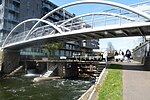Queen Mary University of London (QMUL, or informally QM, and previously Queen Mary and Westfield College) is a public research university in Mile End, East London, England. It is a member institution of the federal University of London. Teaching in Mile End began as a philanthropic endeavour under the auspices of the East London College in the 1880s. Renamed Queen Mary College, after Mary of Teck, the College was admitted to the University of London in 1915. In 1989 the College merged with Westfield College, a college of the University of London, to form Queen Mary and Westfield College.In 1995 Queen Mary and Westfield College merged with St Bartholomew's Hospital Medical College and The London Hospital Medical College to form the School of Medicine and Dentistry (informally known as Barts). Medical students had been informally educated at St Bartholomew's since its foundation as a priory and hospital in 1123, while The London Hospital Medical College had as England's first medical school, formally trained doctors since its inception in 1785. Taken together, these two historic institutions form the present university's earliest foundations.In 2000, Queen Mary and Westfield College rebranded as Queen Mary University of London, and in 2008 the Privy Council granted Queen Mary the authority to award university degrees in its own name; previously degrees had been awarded through the University of London. In 2012 Queen Mary joined the Russell Group of leading British research universities. The following year, the university legally changed its name from Queen Mary and Westfield College, University of London to Queen Mary University of London.Today, Queen Mary has five campuses across East and Central London in Mile End, Whitechapel, Charterhouse Square, Lincoln's Inn Fields and West Smithfield, as well as an international presence in China, France, Greece and Malta. The Mile End campus is the largest self-contained campus of any London-based university. In 2018/19 the university had around 26,000 students. Queen Mary is organised into three faculties – the Faculty of Humanities and Social Sciences, the Faculty of Science and Engineering, and Barts and The London School of Medicine and Dentistry.
Queen Mary is a member of the Russell Group of British research universities, the Association of Commonwealth Universities and Universities UK. Queen Mary is a major centre for medical teaching and research and is part of UCLPartners, the world's largest academic health science centre. Queen Mary runs programmes at the University of London Institute in Paris, taking over the functions provided by Royal Holloway. Queen Mary also collaborates with University of London to offer its Global MBA program. For 2021–22, Queen Mary had a turnover of £625.7 million including £122.9 million from research grants and contracts, with an expenditure of £623.4 million.Queen Mary has produced many notable alumni in various fields of work and study around the world with several alumni having become notable leaders in their respective fields including politics, as heads of state, science, academia, law, history, business, technology, and diplomacy. There are nine Nobel Laureates amongst Queen Mary's alumni, current and former staff. Notable alumni include Ronald Ross, who discovered the origin and cure for malaria, Davidson Nicol, who discovered the breakdown of insulin in the human body, British politician Peter Hain, and Professor Andrew Pollard, the chief investigator of the Oxford–AstraZeneca COVID-19 vaccine.










